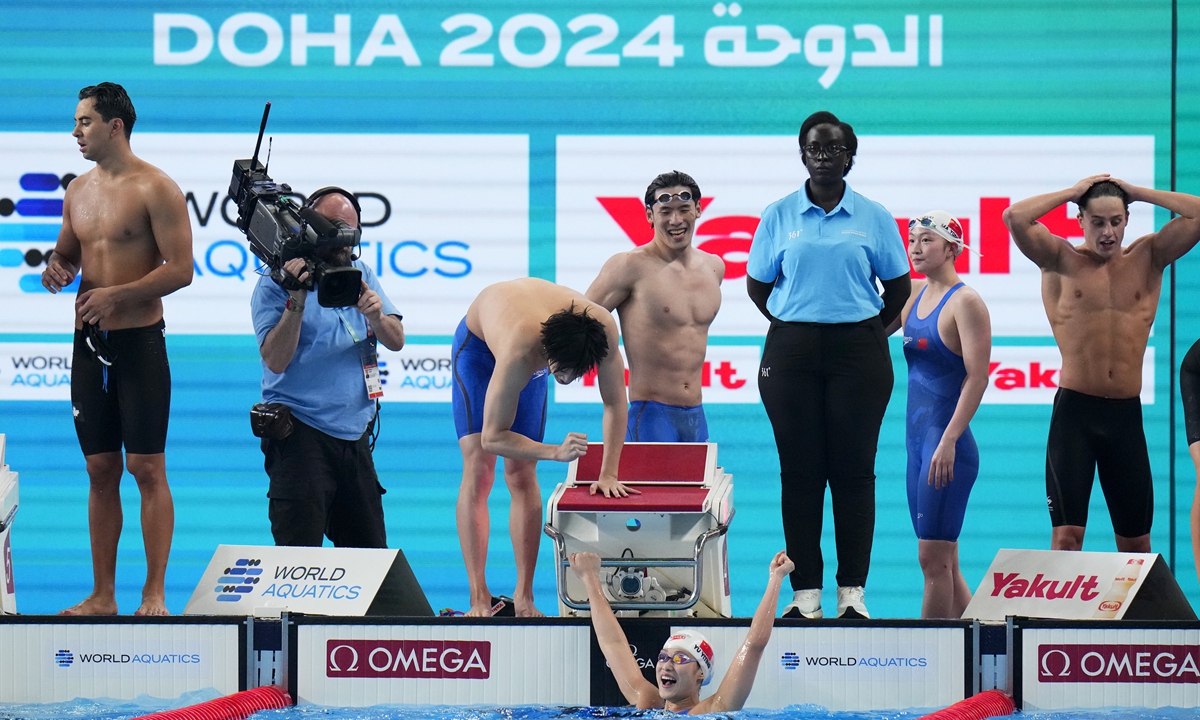
Yu Yiting (in water) of Team China celebrates after the mixed 4x100m freestyle final at the World Aquatics Championships on February 17, 2024 in Doha, Qatar. Photo: VCG
Editor’s Note:
Swimming is gaining increasing popularity in China thanks to Chinese swimmers’ excellent performances in recent years, including three gold, two silver and one bronze medals at the Tokyo Olympics in 2021 – an increase from one gold, two silver and three bronze medals at Rio 2016.
Following the Fukuoka 2023 and Doha 2024 world aquatics championships, some emerging ace swimmers have made their name in the sport such as Qin Haiyang, who set a new world record in men’s 200 meters breaststroke, and 19-year-old Pan Zhanle, a world record holder in the 100 meters freestyle.
Female butterfly specialist Zhang Yufei is also a gold medal contender for the Paris Olympics, after bagging two gold and two silver medals for China at the 2020 Tokyo Olympics, while Li Bingjie strengthened China’s squad depth allowing the team to be able to compete against other major swimming powerhouses such as the US and Australia.
Recently, Chinese swimmers competed domestically for Olympic berths in Shenzhen, South China’s Guangdong Province, where they delivered excellent performances that elevated the expectations of fans for the Paris Olympics.
In this installment of the Road to Paris series, we would like to offer readers some insight into the four aforementioned young swimmers who are the flag bearers of the Chinese team.
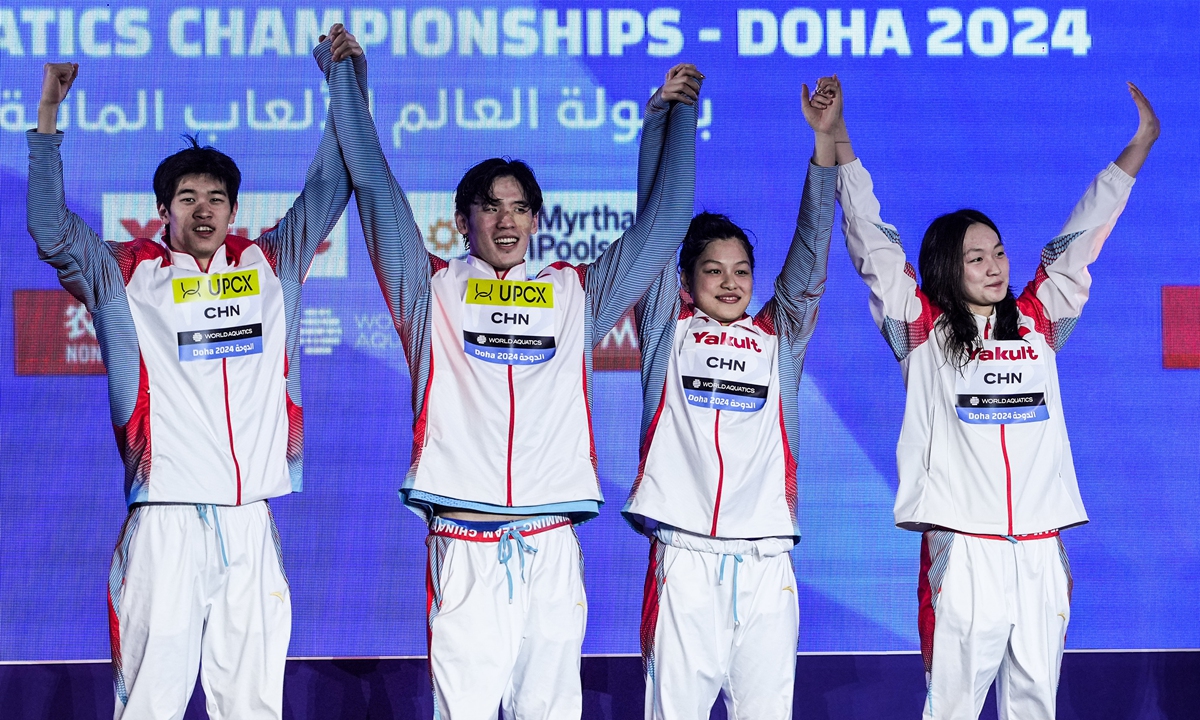
(From left) Gold medalists Pan Zhanle, Wang Haoyu, Yu Yiting and Li Bingjie celebrate after winning the mixed 4x100m freestyle final at the World Aquatics Championships on February 17, 2024 in Doha, Qatar.Photo: VCG
At February’s World Aquatics Championships in Doha, Qatar, the Chinese swimming team accomplished its best results since the 1994 worlds as they dominated the overall medal tally with an impressive haul of 23 gold, eight silver, and two bronze medals in all aquatics sports, including seven golds, three silvers and one bronze from swimming.
World Aquatics President Husain Al-Musallam told the Global Times that he was extremely impressed with the performance of the Chinese athletes in Doha.
Clocking in at 46.80 seconds, Pan Zhanle set a new 100m freestyle world record thanks to his exceptional performance in the leadoff split of China’s gold medal-winning 4x100m freestyle relay.
“China was the dominant country in Doha. You have so many outstanding athletes, and, of course, the world record by Pan was incredibly exciting. China has led the world for many years in diving, but I am happy to see that so much progress is also being made in sports like swimming and artistic swimming,” said Al-Musallam.
The president said Pan’s great performance elevates swimming to a higher level as the 19-year-old finished the worlds with a tally of four golds, marking himself as a force to be reckoned with on the international stage.
As the sole athlete to set a new world record in Doha, Pan solidified his place on the leaderboard by clinching his first individual world title in the 100-meter freestyle final. This result establishes him as one of the leading contenders for a success at the Paris Olympic Games.
Looking ahead to the Paris Games, Al-Musallam anticipates a strong showing from the Chinese athletes.
“I am very confident that these will be an excellent Olympic Games for China. We have seen in Fukuoka and Doha the depth of talent in the Chinese team. I am sure that we will see many Chinese medalists on the podium in Paris,” he noted.
‘Qin Dynasty’
On Tuesday, the 200m breaststroke final of China’s national swimming championships pitted 2024 Doha worlds champion Dong Zhihao against 2023 Fukuoka worlds champion Qin Haiyang.
Qin and Dong, the two favorites to secure a podium finish at the Paris Games, completed a 1-2 finish in the final, surpassing the best Olympic result for Chinese breaststrokers achieved by Yan Zibei, who placed sixth in the 100m breaststroke at the Tokyo Olympic Games.
The 24-year-old Qin made history at the Fukuoka worlds as he became the first swimmer to pull off a hat trick of titles in the 50m, 100m and 200m events at a single edition of the world championships, while also shattering the 200m breaststroke world record.
Qin was honored with the title Male Swimmer of the Year by the World Aquatics in October 2023, becoming the first athlete from the Chinese mainland to win this award. He was also named the Most Valuable Player in the men’s division for sweeping five golds at the Asian Games in Hangzhou, East China’s Zhejiang Province.
While in junior competitions Qin specialized in freestyle, in 2013 his coach Zhao Fei determined to transform him into a breaststroker, which proved to be a turning point for Qin’s career and Chinese swimming history.
Qin said he was ready to pursue his journey at Paris 2024.
“When I finish a race, everything ends. When I take off the gold medals, it’s a new beginning. Each new race, it’s a new challenge, a new beginning for me,” he said.
‘Butterfly Queen’
Zhang Yufei, the ace athlete of the Chinese women’s swimming team, said after bagging six golds at the Hangzhou Asian Games that her goal for the Paris Games is to win three individual medals and four relay medals.
From the Fukuoka worlds, Chengdu Universiade and Hangzhou Asian Games to the World Cup, Zhang endured a hectic schedule in 2023. How she will strike a balance between individual and relay events in Paris remains the major challenge for Zhang, who is dubbed the “Butterfly Queen.”
The 26-year-old won two golds in the 200m butterfly and 4x200m freestyle relay at the Tokyo Olympic Games.
She said earlier that signing up for multiple competitions is one of the ways for her to improve endurance and gear up for Paris Games.
“Each time I take part in a major competition, I compete in a dozen races, including heats and finals. This is to help me get accustomed to the intensity at the Paris Olympic Games. Only in this way do I know how to adjust to multiple races in a short span,” said Zhang.
“If we only talk about personal ideals, I can say what I like and what I don’t like. But if I shoulder the responsibility of the nation at international competitions, there is no choice but to strive for the best,” she noted.
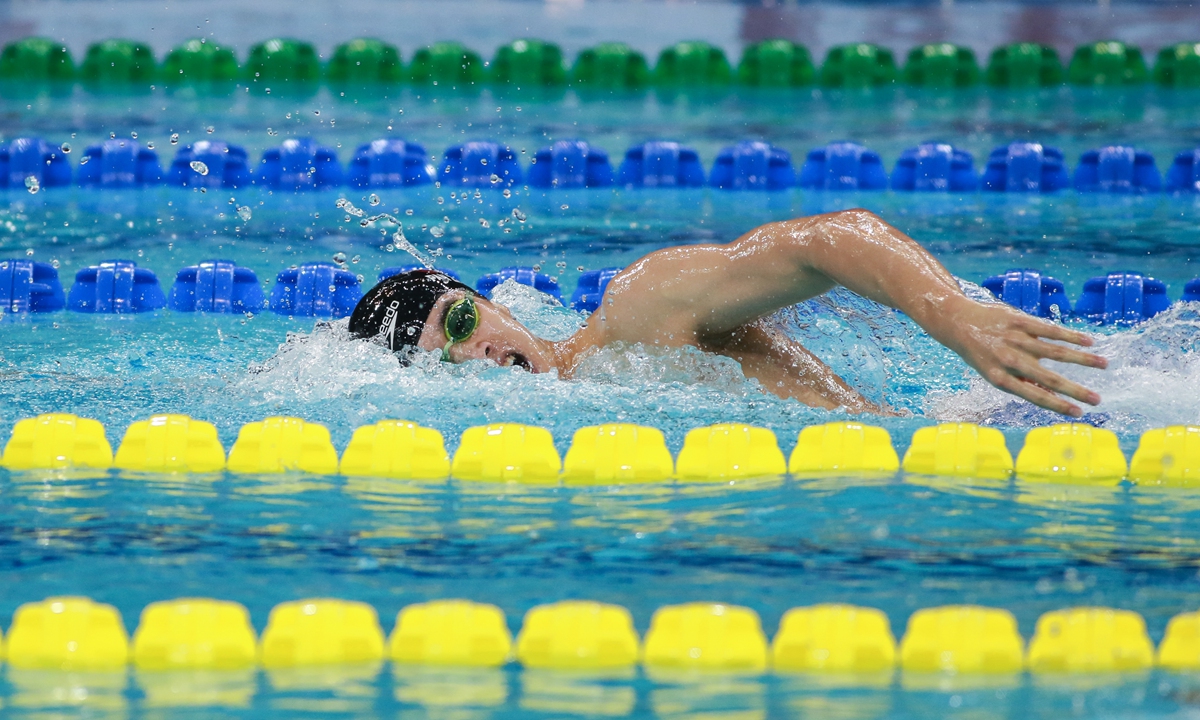
Pan Zhanle competes in the men’s 200m freestyle event at the national swimming championships in Shenzhen, South China’s Guangdong Province, on April 20, 2024. Photo: VCG
Pan excels with under-47s
Pan Zhanle’s name has become synonymous with excellence and consistency lately.
The latest testament to his prowess came on Tuesday at the national swimming championships in Shenzhen where he clinched yet another victory in the men’s 100m freestyle final with a blistering time of 46.97 seconds, marking his third consecutive sub-47-second performance.
Pan’s journey to dominance has been marked by remarkable achievements over the past few months.
It began with his gold medal win at the Hangzhou Asian Games in September 2023, where he shattered records by becoming the first Asian swimmer to break the 47-second barrier, clocking in at 46.97 seconds.
His momentum only surged forward as he made waves at the Doha worlds in February, where he not only secured gold in the men’s 4x100m freestyle relay but also set a new world record of 46.80 seconds in the leadoff leg.
Now, with his recent triumph at the nationals, Pan has once again demonstrated his unwavering dominance in the 100m freestyle event.
Reflecting on his achievement, Pan remains humble yet determined, acknowledging that even greater feats lie ahead, particularly with the looming challenge of the Paris Olympics.
Despite his youth, Pan’s performance stands as a testament to his unparalleled skill and resilience in the pool.
His ability to consistently breach the sub-47-second mark places him in an elite echelon of swimmers, with only a select few achieving such a feat, including him and David Popovici of Romania, who made headlines in 2022 by consecutively breaking the 47-second barrier and setting a world record of 46.86 seconds.
Pan’s success, however, has not been without its challenges. Despite his remarkable achievements, he remains steadfast in his pursuit of further excellence, acknowledging the ever-changing landscape of competitive swimming.
As he sets his sights on the Paris Olympics, Pan remains focused on maintaining a balanced mind-set and approach, emphasizing the importance of adapting to the pressures of elite competition.
“It will be my first time participating in the Olympics. My main goal is to relax and not feel too much pressure. I’m not concerned about the results for now; I just want to give it my all,” Pan said.
“I really want to achieve a good result. I can’t afford to be impatient during the Olympics. I need to calm down and stabilize.”
Li aims higher
Distance swimmer Li Bingjie’s tale is one of redemption and tenacity.
Bursting onto the international scene at the age of 15 during the 2017 World Championships in Budapest, Hungary, she captured silver in the 800-meter freestyle and bronze in the 400-meter freestyle.
Despite her early promise, Li faced a bitter taste of disappointment after failing to advance in the preliminaries of the women’s 400-meter freestyle at the 2019 world championships.
Subsequent years saw Li grappling with profound setbacks and self-doubt, her once-promising trajectory veering into a downward spiral.
Amid injuries and faltering confidence, she confronted her fears head-on, shedding her long locks in a symbolic gesture of renewal reminiscent of her teenage debut.
Her perseverance bore fruit in 2021, as she triumphed on the grandest of stages, securing a gold and a bronze medal at the Tokyo Olympics.
Li’s main disciplines, the distance freestyles 400, 800 and 1500 meters, are fiercely competitive, with US swimmer Katie Ledecky dominating the disciplines with seven Olympic golds and 21 world championship titles.
At the Doha worlds held in February, Li was seen as the anchor for the team’s gold medal haul in the 4x200m free and 4x100m mixed relays.
“Defending the glory is much harder than conquering it. It’s normal to fail in trying to conquer, but if you can’t defend a title, you’ll be vulnerable to criticism,” Li said.
“I’m more cautious and focused on strategy. I will put forward my best efforts to strive for breakthroughs at the Olympics.”

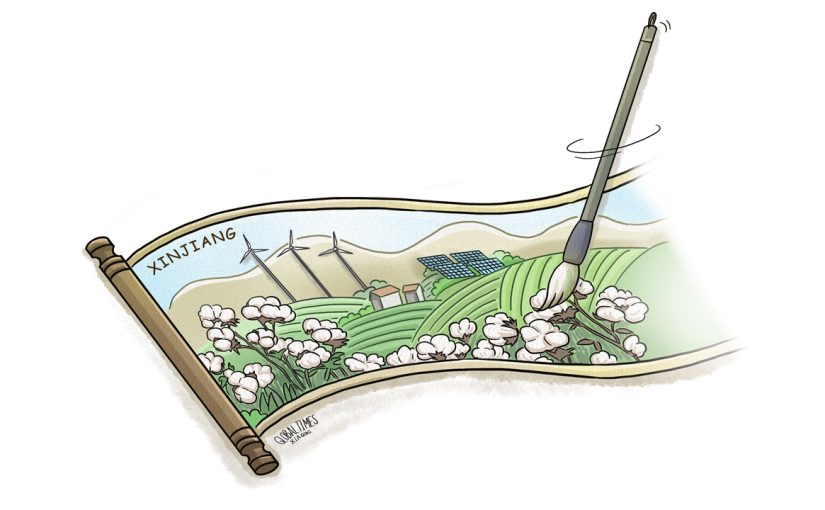
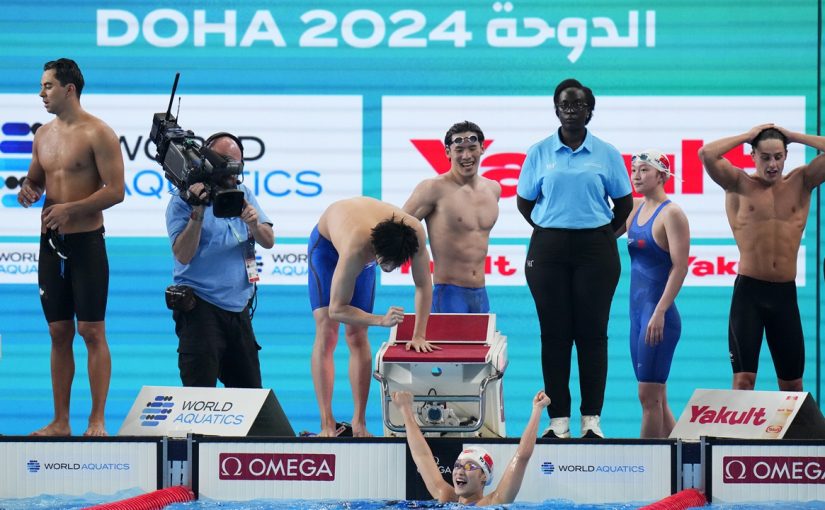





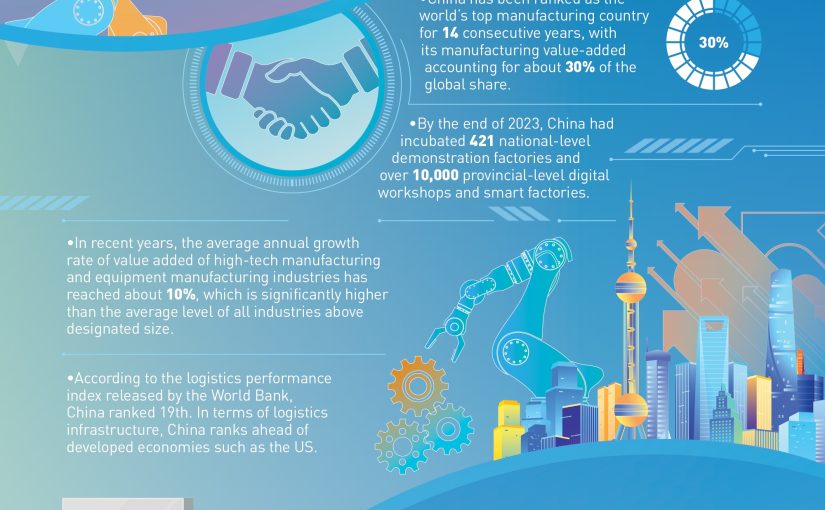


 A Shenzhou-17 taikonaut during an extravehicular repair mission, March 2, 2024. /CFP
A Shenzhou-17 taikonaut during an extravehicular repair mission, March 2, 2024. /CFP 

 Director Chen Jianying works with her team. /Zeng Chen
Director Chen Jianying works with her team. /Zeng Chen 
 A model presents creations from AMI 2024 Fall/Winter collections in Suzhou, Jiangsu province. [Photo provided to China Daily]
A model presents creations from AMI 2024 Fall/Winter collections in Suzhou, Jiangsu province. [Photo provided to China Daily] 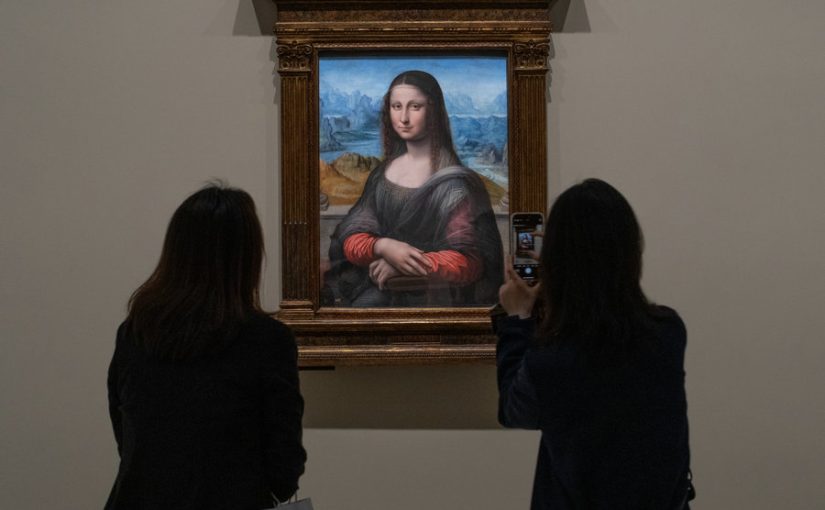
 Exhibition
Exhibition

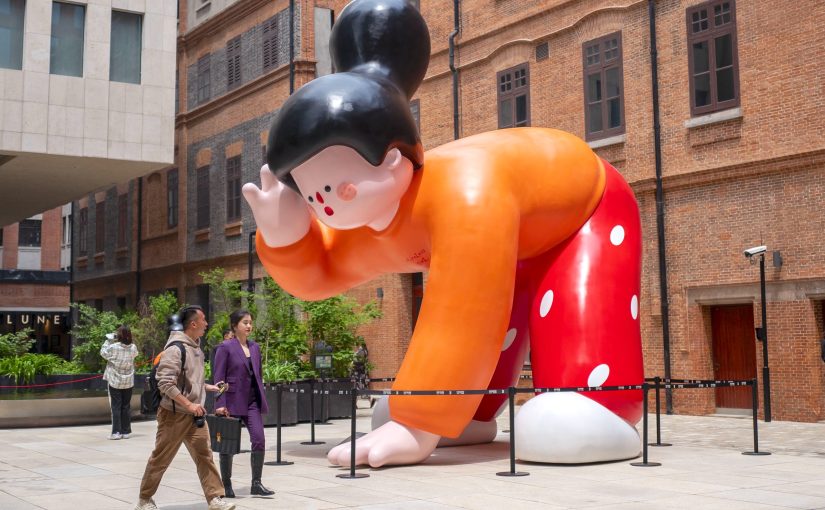
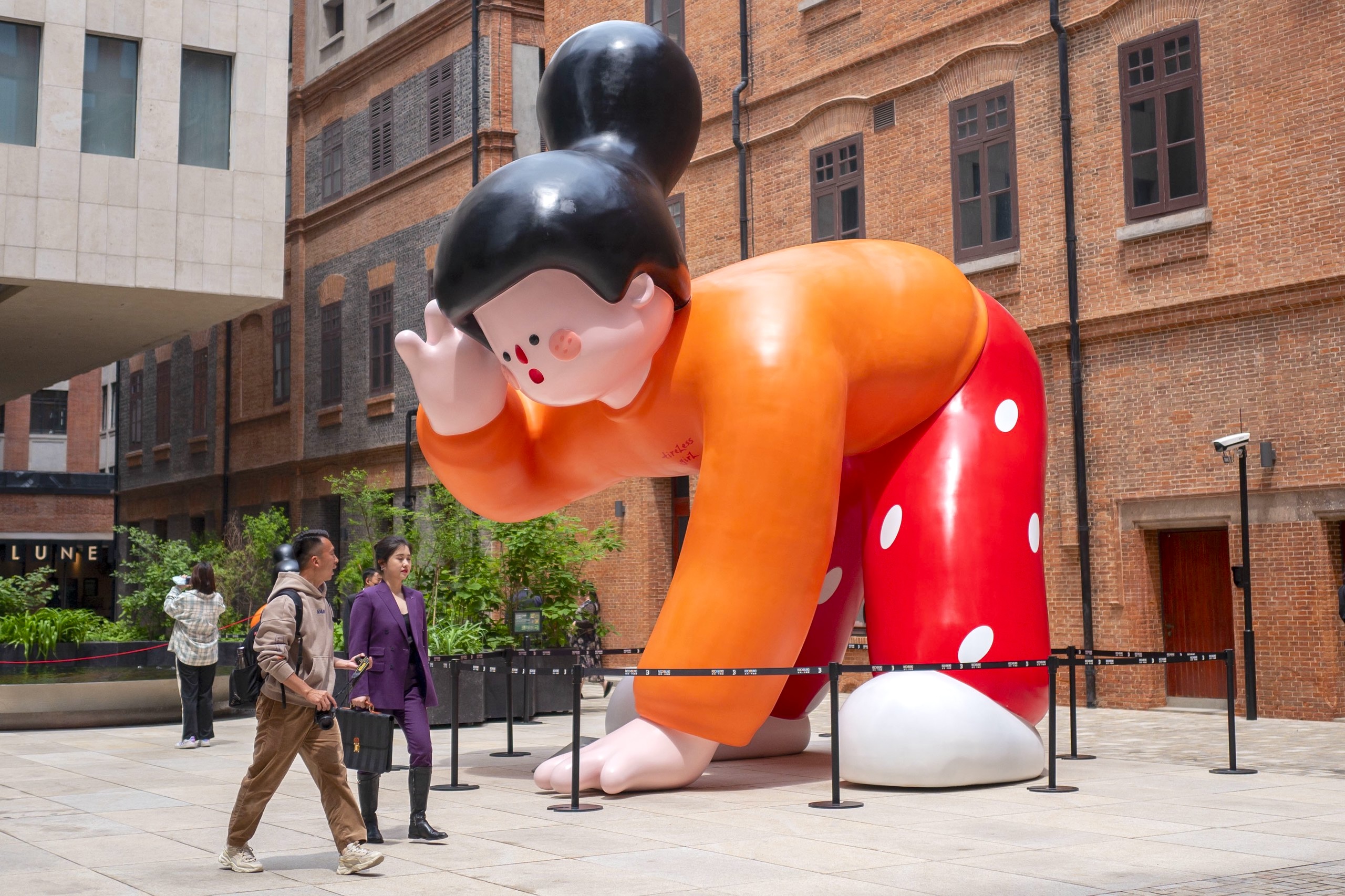 A “Tireless Girl” art installation is pictured at the ROCKBUND in Shanghai on April 22, 2024. /IC
A “Tireless Girl” art installation is pictured at the ROCKBUND in Shanghai on April 22, 2024. /IC  A “Tireless Girl” overlooks visitors from the rooftop at the ROCKBUND in Shanghai on April 22, 2024. /IC
A “Tireless Girl” overlooks visitors from the rooftop at the ROCKBUND in Shanghai on April 22, 2024. /IC  Visitors take photos of “Tireless Girl” art installations at the ROCKBUND in Shanghai on April 22, 2024. /IC
Visitors take photos of “Tireless Girl” art installations at the ROCKBUND in Shanghai on April 22, 2024. /IC  Two “Tireless Girl” art installations are pictured at the ROCKBUND in Shanghai on April 22, 2024. /IC
Two “Tireless Girl” art installations are pictured at the ROCKBUND in Shanghai on April 22, 2024. /IC